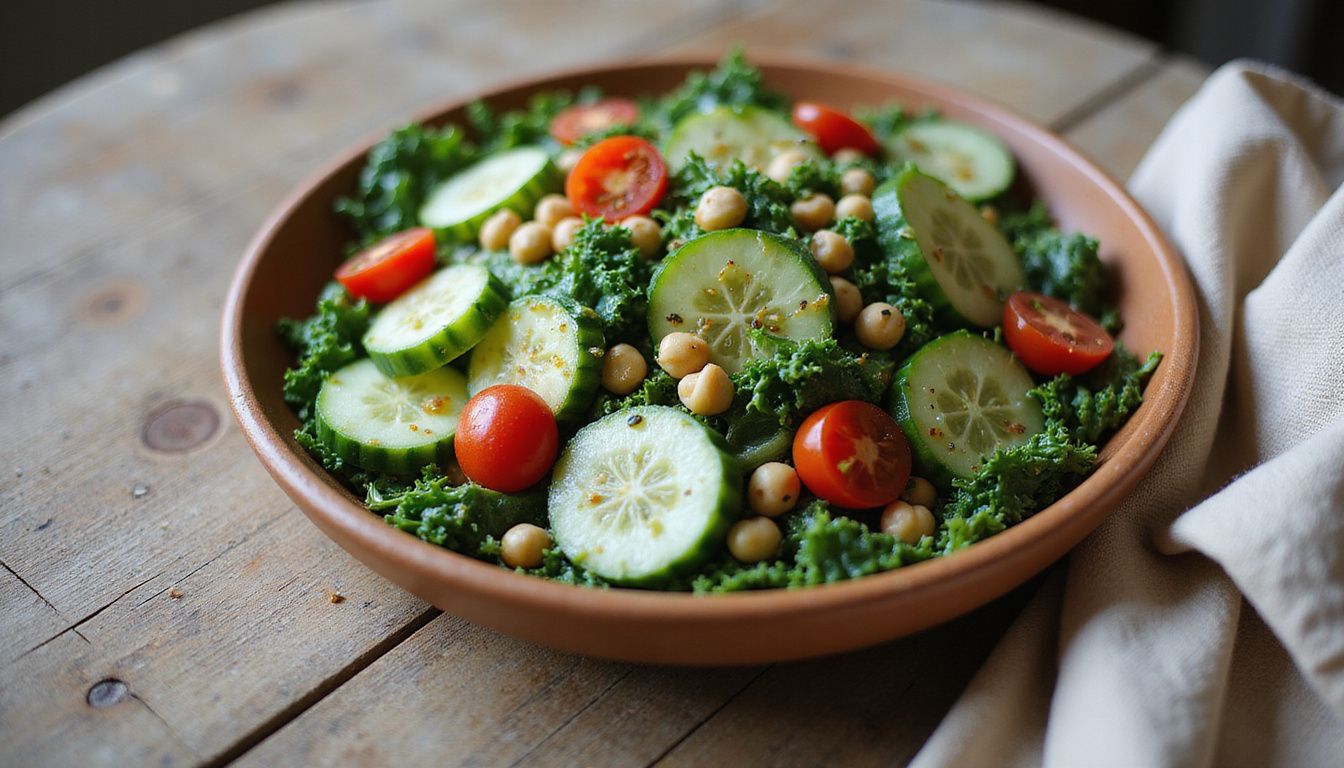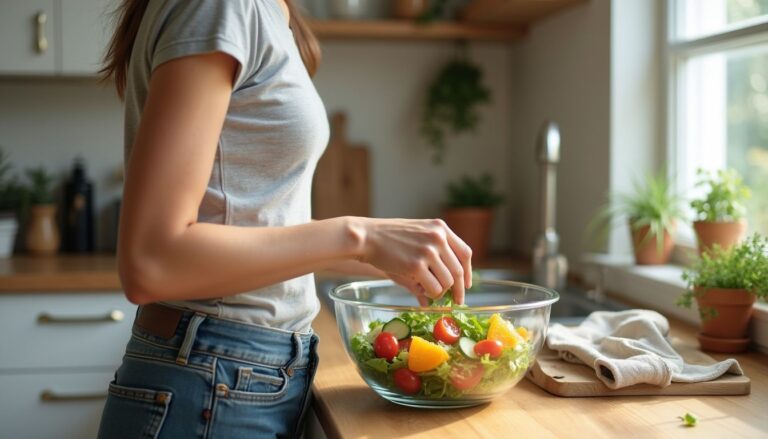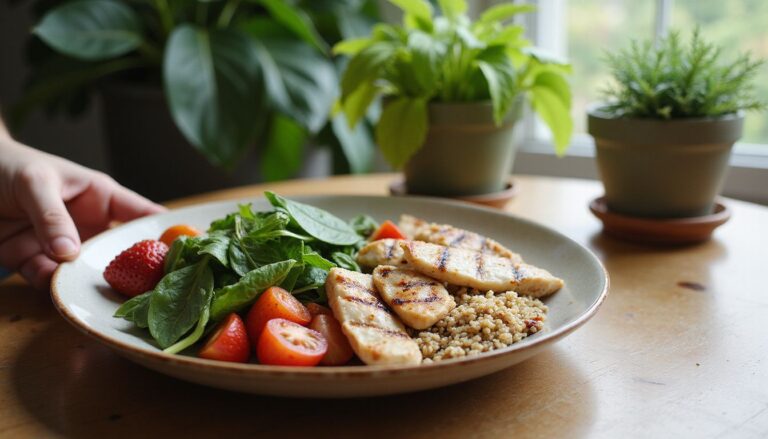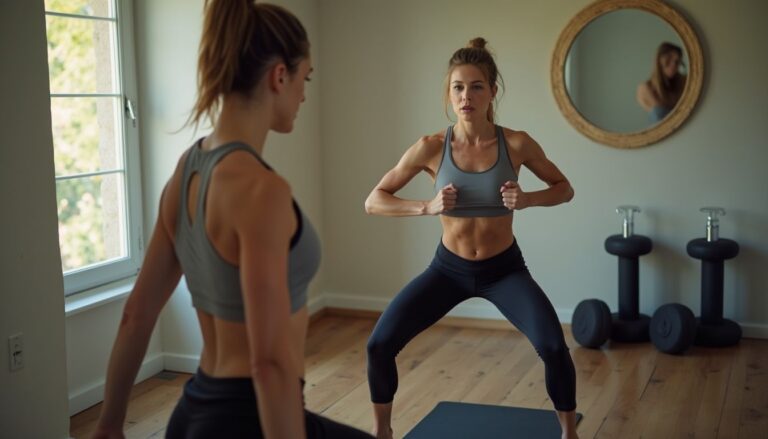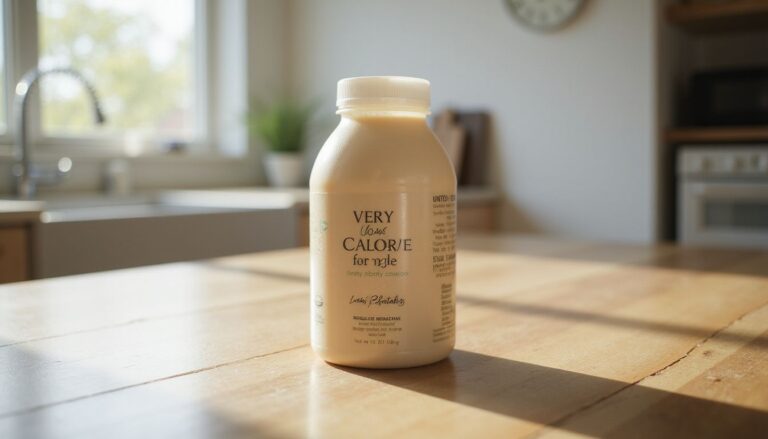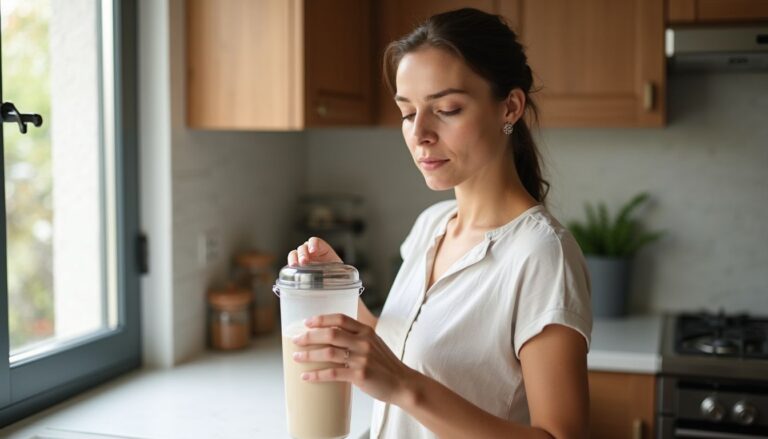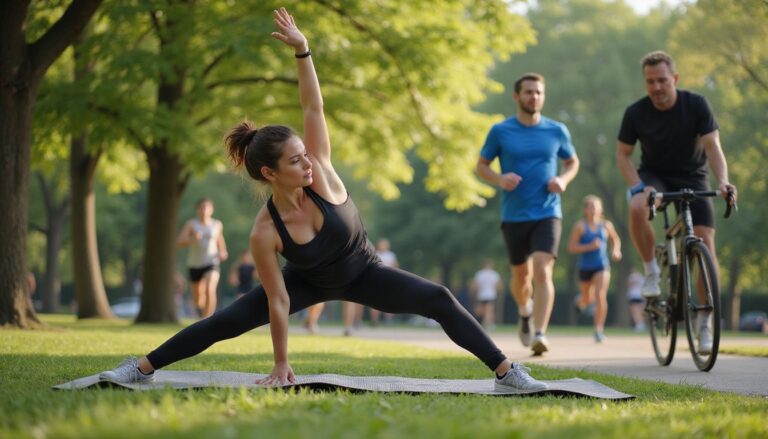High-Protein Salad Recipe For Weight Loss: Healthy Cucumber Salads To Shed Pounds
Our Nutrition Assistant AI Suite will transform your body. You will lose fat, get toned, and build muscle. Gain confidence and optimal health.
Feeling stuck with meals that leave you hungry? A high-protein salad can change that. Research from Penn State University found that starting a meal with a light veggie salad can lower total calorie intake, which supports weight loss.
This guide shares simple, healthy salad recipes that highlight cucumber for crunch and hydration. You will learn quick methods, smart toppings, and balanced dressings that make salads for weight loss taste great and keep you full.
Key Takeaways
- Starting a meal with a high-protein cucumber salad, based on a 2004 Penn State study, can reduce total calories at that meal.
- Dietitian Amy Shapiro suggests 3 to 5 ounces of lean protein, such as chicken, tofu, or eggs, to boost fullness and protect muscle.
- Cucumber has lots of water and only 16 calories per cup, so it adds volume without extra sugar or fat.
- Choose spinach or romaine over iceberg for more fiber, vitamins, and better hunger control.
- Use vinaigrettes with olive oil or Greek yogurt dressings instead of heavy creamy dressings to manage calories.
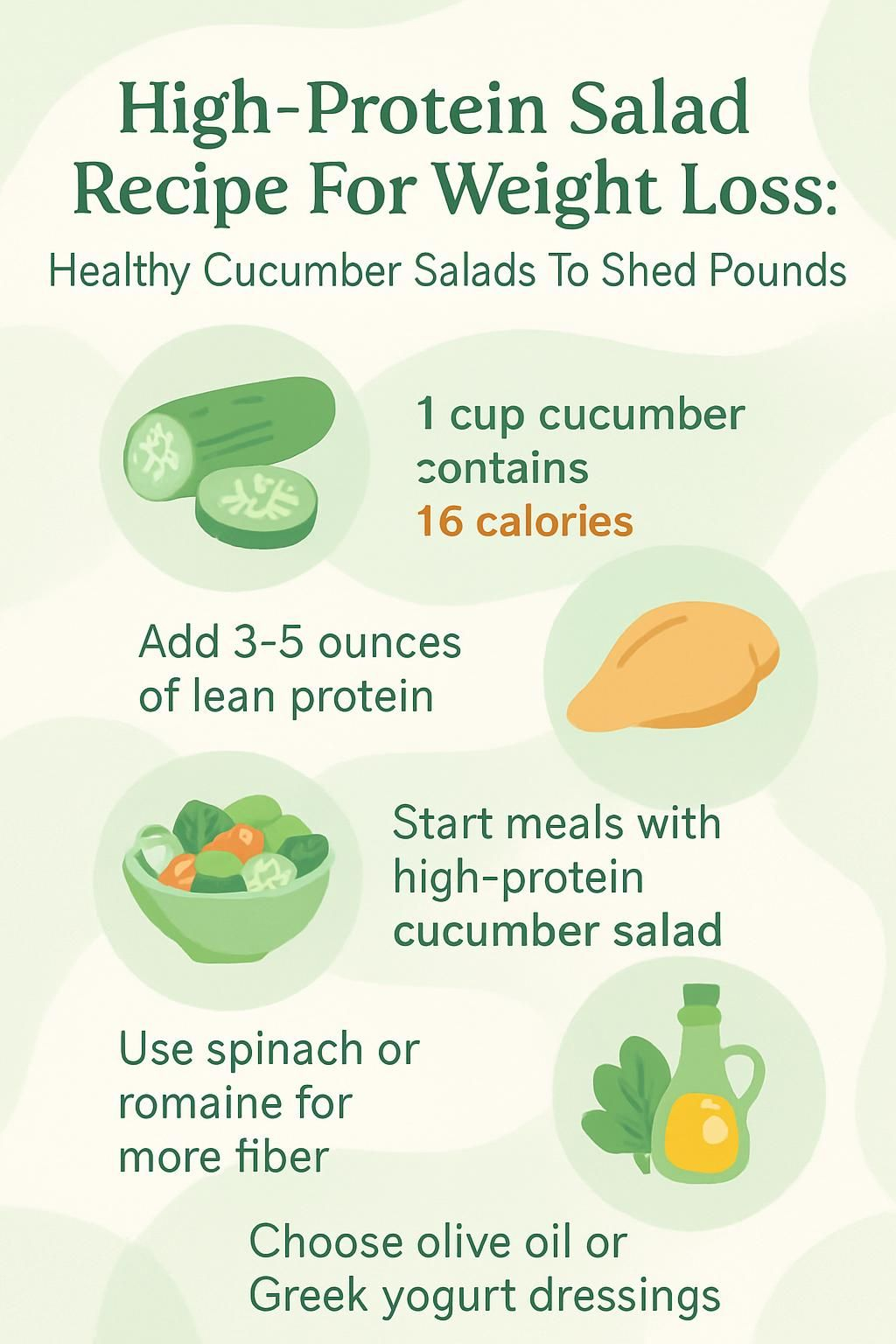
Why High-Protein Salads Are Ideal for Weight Loss
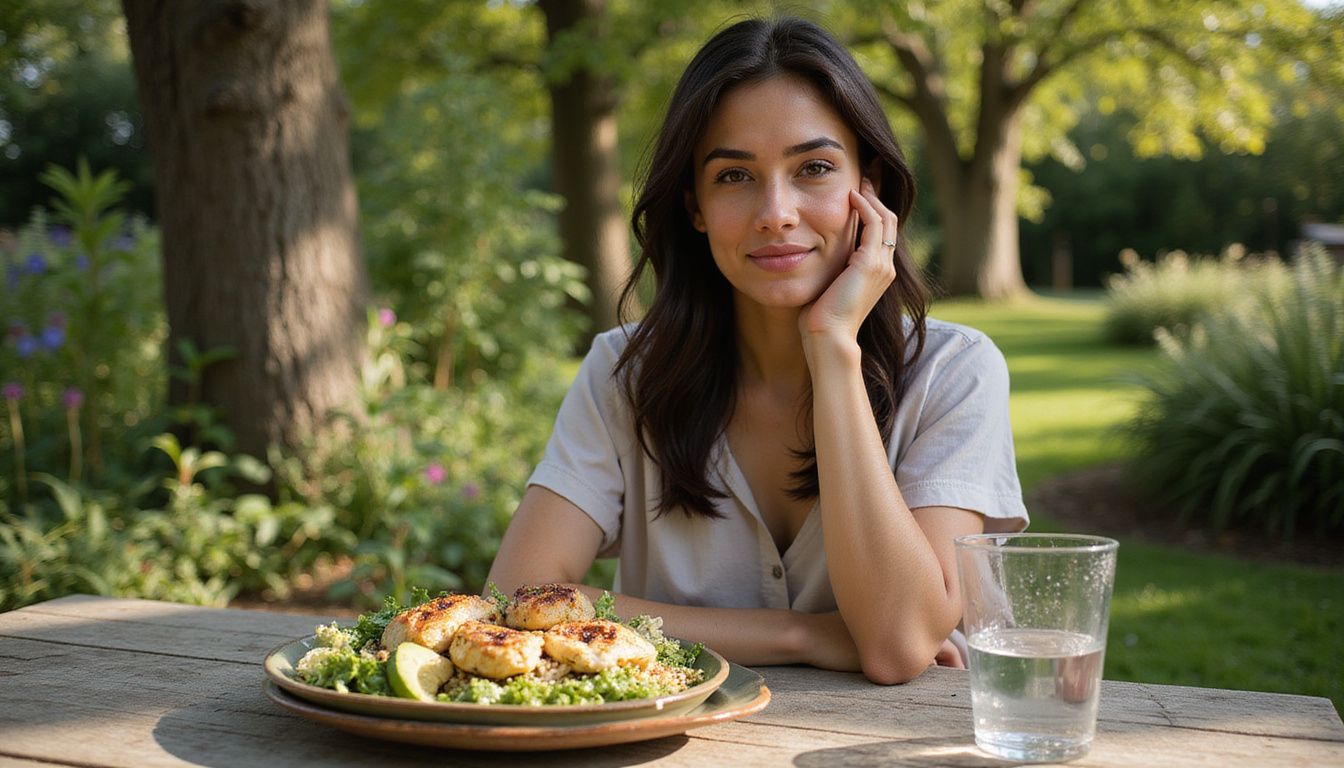
Protein-rich salads help you stay satisfied and support steady progress. Toppings like grilled chicken, tofu, or beans turn a bowl of greens into a complete, healthy salad.
How does protein help with weight loss?
Protein keeps you full longer after a meal. Amy Shapiro, RD, recommends adding 3 to 5 ounces of lean protein, such as grilled chicken, tofu, or hard-boiled eggs, to raise satiety and cut between-meal snacking.
Protein also has a higher thermic effect. Your body burns slightly more calories digesting it than it does with carbs or fat.
Getting enough protein protects your muscles while you lose weight. Try chickpeas, black beans, canned salmon, shrimp, or marinated tofu for quick salad protein.
These choices help maintain metabolism and reduce the risk of muscle loss during a calorie deficit.
Protein is the most satiating nutrient; it takes longer to break down and keeps you fuller longer, says Amy Shapiro, RD (Real Nutrition).
What are the weight loss benefits of cucumber?
Cucumber adds volume for very few calories, which supports portion control. In Penn State research, meals that began with salads made from low-calorie vegetables like cucumber, tomato, carrot, and celery led to lower calorie intake at that meal.
Each cup of cucumber brings water, a bit of fiber, and refreshing crunch without added sugar or fat. That combination helps manage hunger and supports hydration.
Use cucumber as a base for lunch salads, or mix it into chickpea salad or chicken salad to increase fullness without adding many calories.
Key Ingredients for a High-Protein Cucumber Salad
Cucumber pairs well with grilled chicken breast, chickpeas, or tofu for solid protein. Add healthy fats like avocado or olive oil for flavor, nutrient absorption, and balance.
Using leafy greens as your salad base
Use a blend of butter lettuce and spinach, about 6 ounces total, to create a light, filling base. Leafy greens add fiber and volume with few calories.
Romaine is nutrient dense and crisp, which matches well with cucumber. Pre-chopped bags save time and keep texture consistent.
Mix kale, spinach, and romaine to raise fiber and vitamin variety. On busy days, I rely on mixed greens for lunch because they keep me satisfied without feeling heavy.
Which protein sources work best: grilled chicken, tofu, or chickpeas?
All three deliver good protein, and each brings a different taste and texture. Choose one or rotate them to keep meals interesting.
- Grilled chicken gives 3 to 5 ounces of lean protein per serving. It works in Caesar-style salads and Tex-Mex bowls.
- Tofu suits plant-based diets. Half a cup of firm tofu offers about 10 grams of protein and takes on bold flavors.
- Chickpeas bring protein and fiber, around 7 grams per half cup. They are perfect for a no-cook 10-minute meal.
- Chicken supports muscle while staying lower in saturated fat than bacon or full-fat cheese.
- Tofu and chickpeas fit Mediterranean-style salads with olive oil vinaigrette or Greek yogurt dressing.
- Pair any protein with arugula or kale for extra iron and a pleasant bite.
- Grill extra chicken at dinner. Use leftovers the next day in a spring salad with avocado dressing on the side.
- Canned salmon or tuna with cucumber raises omega-3 fats without the sodium load of some bottled dressings.
- Pick roasted turkey or marinated tofu instead of fried meats to cut calories while keeping flavor.
How do healthy fats like avocado or olive oil support your salad?
Protein makes your salad filling, and healthy fats increase satisfaction and flavor. They also help your body absorb vitamins A, D, E, and K from vegetables.
Registered dietitian Jessica Cording suggests one tablespoon of ground flaxseed daily as an easy source of healthy fat. Olive oil vinaigrettes taste bright and may help steady blood sugar.
Avocado adds creamy texture for fewer calories than heavy dressings. Nuts and seeds, such as walnuts or almonds, give crunch and important minerals. Measure portions to control calories.
I use two teaspoons of extra virgin olive oil on a large lunch salad. It keeps me full and focused until dinner.
What are the best low-calorie vegetables to add?
Low-calorie vegetables add bulk, color, and nutrients without pushing calories too high. Mix several for taste and texture.
- Cucumber hydrates and adds fiber at only 16 calories per cup. Fresh dill or a bit of blue cheese can boost flavor.
- Romaine is crisp and very low in calories, under 10 per cup, and holds dressings well.
- Carrots bring sweetness and crunch, about 25 calories per half cup shredded.
- Zucchini, about 20 calories per cup julienned, blends well with light vinegar dressings.
- Broccoli florets are about 15 calories per half cup and supply vitamin C and fiber.
- Bell peppers stay under 30 calories per half cup and add color and antioxidants.
- Celery adds a clean bite at about 6 calories per stalk, great with lemon and parsley or arugula.
- Tomatoes bring juiciness and antioxidants at roughly 22 calories each, depending on size.
- Asparagus, sliced after grilling, offers a fresh taste at about 3 calories per spear.
These vegetables create a strong base. Then, add plant or animal proteins like chickpeas or chicken to reach your protein target.
What optional toppings enhance flavor and nutrition?
Smart toppings elevate flavor and nutrition without many extra calories. Choose a few so the bowl stays balanced.
- Homemade pickled banana peppers add tang with minimal calories.
- Chopped dates supply gentle sweetness, fiber, and potassium.
- One tablespoon of ground flaxseed increases fiber and omega-3 fats.
- Nutritional yeast gives a cheesy taste plus B vitamins and some protein.
- Everything seasoning adds bold flavor without much sodium.
- Roasted chickpeas or a small handful of almonds raise protein and crunch.
- Whole-grain croutons made at home add texture and fiber with less oil.
- Feta or strained yogurt offers creamy saltiness and calcium.
- Black pepper, curry powder, or mustard powder deliver layered flavor for few calories.
At lunch, I often mix roasted chickpeas with red onion. The combo keeps me full and satisfies the need for crunch.
Recipe 1: Classic Cucumber and Grilled Chicken Salad
This classic bowl balances lean protein, colorful vegetables, and a light dressing. It makes an easy dinner that feels fresh yet filling.
What ingredients do you need for this salad?
Gather simple ingredients from your local grocery store. Most are pantry staples or easy to find produce.
- 3 to 5 ounces grilled chicken breast for lean protein and muscle support.
- 1 cup sliced cucumber for a crisp, low-calorie base.
- 2 cups mixed leafy greens such as spinach or arugula for fiber and vitamins.
- 1/2 cup cherry tomatoes for color and nutrients.
- 1/4 cup diced bell peppers for crunch and natural sweetness.
- 1 tablespoon olive oil or a few avocado slices for healthy fats and vitamin absorption.
- 1 tablespoon sunflower or pumpkin seeds for optional crunch and extra protein.
- 1/4 cup shredded carrots for more fiber and color.
I often make this salad after workouts. It feels light yet keeps me full for hours.
How do you prepare the classic cucumber and grilled chicken salad?
Use fresh produce, lean protein, and a measured dressing. These steps come together quickly.
- Grill one boneless, skinless chicken breast until cooked through. Slice into thin strips.
- Chop two cups of mixed greens, one medium cucumber, a handful of cherry tomatoes, half a bell pepper, and one small carrot.
- Toss the vegetables in a large bowl to create a colorful, nutrient-dense base.
- Place the grilled chicken on top to provide about 25 to 30 grams of protein.
- Drizzle with one tablespoon of olive oil or whisk a quick Dijon vinaigrette.
- Sprinkle a small amount of sliced almonds or pumpkin seeds for texture.
- Mix gently so every bite includes protein, healthy fat, and fresh vegetables.
- Serve right away or refrigerate in an airtight container for meal prep.
Next, try a bright cucumber and chickpea salad with lemon for a plant-forward option.
Recipe 2: Cucumber and Chickpea Salad with Lemon Dressing
This salad offers protein from legumes plus the cooling crunch of cucumber. The lemon dressing wakes up every bite.
What ingredients are required for the chickpea cucumber salad?
Each ingredient supports fullness, flavor, or both. Keep a can of chickpeas on hand to speed up prep.
- 1 cup sliced cucumber for a crisp, low-calorie base with high water content.
- 1/2 cup canned or cooked chickpeas as the main protein source.
- 1 cup mixed leafy greens such as spinach, kale, or romaine for fiber and nutrients.
- 1/4 cup diced red onion for sharp flavor without many calories.
- 1/4 cup bell peppers for color, crunch, and vitamin C.
- 1 tablespoon ground flaxseed for healthy fats and a fuller feeling.
- Juice of one fresh lemon for a bright, low-calorie dressing.
- 1 tablespoon nutritional yeast for mild cheesy flavor and B vitamins.
What are the step-by-step preparation instructions?
Assemble the vegetables, then finish with simple seasonings. Keep the dressing light to manage calories.
- Rinse canned chickpeas in a colander under cold water. Drain well to lower sodium.
- Slice one large cucumber into thin rounds or half moons.
- Chop leafy greens to build a fiber-rich base.
- Dice bell peppers and red onion for color and crunch.
- Combine cucumber, chickpeas, greens, onion, and peppers in a large bowl.
- Sprinkle ground flaxseed and nutritional yeast across the bowl.
- Squeeze fresh lemon juice over the salad. Add a pinch of salt and black pepper if desired.
- Toss until coated evenly. Taste and adjust seasoning.
- Serve right away or chill briefly to let flavors meld.
For a heartier meal, add roasted chickpeas or a scoop of cooked quinoa.
Recipe 3: Smoked Salmon and Cucumber Salad with Dill Yogurt Sauce
Smoked salmon, cool cucumber, and a tangy dill yogurt sauce make a protein-packed meal. It feels special but takes just minutes.
What ingredients make up this smoked salmon cucumber salad?
Balanced textures and savory flavors make this salad satisfying. The yogurt sauce keeps calories in check.
- 3 ounces smoked salmon for protein and healthy fats.
- 1 cup sliced cucumber for crunch and hydration.
- 1 cup mixed leafy greens to increase fiber and fullness.
- 1/4 cup cherry tomatoes for color and vitamin C.
- 2 tablespoons Greek yogurt mixed with 1 tablespoon lemon juice and 1 tablespoon fresh dill for a creamy sauce.
- 1 teaspoon capers for a briny kick that pairs well with fish.
- Optional healthy fats, such as a few avocado slices or a drizzle of olive oil.
- A small sprinkle of almonds or walnuts for crunch and extra protein.
- Optional fruit accents, such as a few mandarin orange segments or a few raisins, for light sweetness.
I often make this after long workouts. Greek yogurt replaces mayonnaise for a creamy texture with fewer calories.
How do you prepare the salad with dill yogurt sauce?
Use fresh ingredients and light mixing to protect the salmon’s texture. The steps are simple.
- Combine Greek yogurt, chopped dill, and lemon juice in a small bowl. Stir until smooth.
- Slice cucumber thinly, halve cherry tomatoes, and chop romaine or baby spinach.
- Add cucumber, tomatoes, and greens to a large bowl to form the base.
- Lay smoked salmon on top so each serving gets a fair share.
- Drizzle the dill yogurt sauce over the salad.
- Scatter capers for extra tang and balance.
- Toss gently so the salmon stays in pieces and everything gets coated.
- Serve immediately so the cucumbers stay crisp and the salmon stays tender.
Prefer tuna? Swap in drained canned tuna for a more budget-friendly version.
Tips to Build a Perfect Weight-Loss Salad
A great weight-loss salad balances protein, fiber, and healthy fats. Think of it as a three-part formula you can repeat.
How do you balance protein, fiber, and healthy fats?
Start with 3 to 5 ounces of lean protein, like grilled chicken, tofu, or chickpeas. Add at least 2 cups of leafy greens and low-calorie vegetables such as cucumber and tomatoes for fiber.
For extra staying power, add half a cup of beans or chickpeas. Include 1 to 2 tablespoons of healthy fats, such as avocado, seeds, or olive oil. A teaspoon of ground flaxseed or chia can add omega-3s and more fiber.
Combine plant and animal proteins for variety and longer fullness. Adjust portions to fit your calorie needs while keeping texture and flavor in mind.
What dressings should you avoid to keep calories low?
Skip heavy dressings such as ranch and Caesar, which often exceed 140 calories per two tablespoons. Many store-bought options add sugar, sodium, and processed oils.
Choose clear vinaigrettes made with olive oil, vinegar, lemon juice, and herbs. Greek yogurt or hummus can also stand in for creamy dressings. Measure 1 to 2 tablespoons per salad to stay on track.
Why add colorful vegetables to your salad?
Color signals a variety of nutrients. Orange carrots offer beta-carotene for eyes. Red peppers and tomatoes supply lycopene for heart health. Green broccoli provides sulforaphane, a compound linked to lower inflammation.
Colorful vegetables also improve taste and crunch. Studies suggest that eating a wider variety of vegetables supports fullness and better nutrient intake.
Common Mistakes to Avoid in Weight-Loss Salads
A few small errors can raise calories or lower nutrition. Avoid these pitfalls to get better results.
Why is using only iceberg lettuce a mistake?
Iceberg has less fiber and fewer vitamins than greens like spinach or romaine. One cup of spinach gives far more vitamin K than the same amount of iceberg.
Low fiber means iceberg salads often do not keep you full. Mixing greens such as spinach and romaine adds flavor, color, and lasting satisfaction.
How can creamy dressings sabotage your salad?
Heavy creamy dressings can turn a light meal into a calorie bomb. A large serving can add hundreds of calories and often includes added sugars and preservatives.
They also cover up fresh vegetable flavors. I switched to lemon juice or yogurt-based dressings and noticed better taste and fewer daily calories.
Try hummus, vinaigrette, or a squeeze of citrus to protect your goals.
What high-calorie toppings should you limit?
Cheese, bacon, fried chicken, and store-bought croutons add quick calories. A salad with generous amounts of these can reach 400 calories fast.
Use only a small sprinkle of cheese or nuts. Replace bacon bits with roasted mushrooms or tempeh bacon for savory flavor with fewer calories.
Dried fruit is concentrated sugar. Fresh fruit adds sweetness with more volume. Make crunchy roasted chickpeas at home and bake whole-grain croutons with light oil and herbs.
Additional High-Protein Salad Ideas
Rotate new bowls to avoid boredom. A few fresh combinations can keep your routine enjoyable.
What makes kale and quinoa cucumber salad with grilled shrimp healthy?
Kale provides fiber and vitamins A, C, and K. Quinoa is a complete plant protein that supports muscle repair. Grilled shrimp adds lean protein and omega-3 fats for heart health.
Cucumber adds low-calorie crunch. A lemon or olive oil dressing provides healthy fats for vitamin absorption. This mix kept me full for hours and fueled an afternoon workout.
How to make a Greek-inspired cucumber salad with feta and chicken?
This Greek-style bowl blends freshness with high-protein ingredients. Follow these steps for a quick, satisfying meal.
- Gather cucumber, grilled chicken breast, feta, cherry tomatoes, red onion, Kalamata olives, and romaine or mixed greens.
- Wash and dry 2 cups of greens for a crisp base.
- Slice 1 cup of cucumber into half moons for crunch and hydration.
- Dice 3 to 5 ounces of grilled chicken for lean protein and fullness.
- Sprinkle 1 to 2 tablespoons of feta for tang and calcium.
- Halve cherry tomatoes and thinly slice a bit of red onion.
- Add 5 to 6 olives per salad for flavor and healthy fats.
- Whisk 1 tablespoon olive oil, juice from half a lemon, salt, pepper, and oregano.
- Dress lightly to keep calories down and taste bright.
- Toss gently and serve immediately.
You get lean protein, healthy fats, and fiber, which suits a weight loss plan focused on satiety and nutrition.
What is a spicy tuna cucumber salad with sesame dressing?
This option is high in protein and low in calories. It comes together fast, which helps on busy days.
- Use one can of wild tuna packed in water for lean protein and omega-3s.
- Slice one medium cucumber for crisp texture and hydration.
- Add two cups of mixed greens for vitamins A, K, and C.
- Include half an avocado for creamy, heart-healthy fats.
- Toss in shredded carrots and sliced bell peppers for fiber and color.
- Whisk 1 tablespoon sesame oil, 2 teaspoons low-sodium soy sauce, and 1 tablespoon rice vinegar.
- Add diced chili peppers for heat. Capsaicin may slightly boost metabolism.
- Top with a teaspoon of toasted sesame seeds for nutty flavor.
- Refrigerate up to two days. It is ideal for meal prep lunches.
This spicy tuna cucumber salad keeps calories in check while delivering bold flavor and solid protein.
Benefits of Including High-Protein Salads in Your Diet
High-protein salads help manage hunger and support steady energy. They also make it easier to meet daily vegetable goals.
How do high-protein salads keep you full longer?
Protein slows digestion, so you stay satisfied longer after eating. A salad with 3 to 5 ounces of grilled chicken or tofu can control appetite for several hours, as Amy Shapiro recommends.
Adding half a cup of chickpeas or black beans brings more fiber and protein. In my meal prep, protein-heavy salads keep me full all afternoon, while plain veggie salads leave me hungry.
Why are these salads good for muscle retention during weight loss?
Higher protein intake helps protect lean muscle during a calorie deficit. Chicken, fish, beans, and tofu are reliable sources.
Many dietitians suggest 0.8 to 1.2 grams of protein per kilogram of body weight per day while cutting calories. Protein supports repair after workouts and lowers the risk of muscle breakdown.
Regular high-protein cucumber salads, such as those with chicken or chickpeas, can support metabolism and strength while you lose weight.
What essential nutrients do these salads provide?
Spinach and romaine deliver vitamins A, C, K, and folate. Cucumber adds hydration and vitamin K. Chickpeas and beans provide plant protein, fiber, and iron.
Carrots and bell peppers add beta-carotene and vitamin C. Ground flaxseed brings omega-3 fats and extra fiber. Tomatoes supply lycopene and other antioxidants.
Red onions and pickled peppers add flavor plus small amounts of minerals. Nutritional yeast adds B vitamins, including B12, which supports metabolism.
For medical conditions or specific diet needs, consult a registered dietitian or healthcare professional for personal guidance.
Conclusion
High-protein cucumber salads offer a simple path to healthy weight loss. Fresh vegetables and lean protein help you stay full while supporting muscle. Light vinaigrettes and yogurt dressings keep calories in check.
Evidence supports eating a salad before the main course to reduce calorie intake1. Jessica’s Daily Salad shows how smart prep and steady habits can drive real change, with reported loss of more than 290 pounds across two people.
Make these nutrient-rich, high-protein salad recipes part of your routine. Small, consistent choices can make weight management easier and mealtimes more enjoyable.
…
1 Rolls BJ, et al., North American Association for the Study of Obesity Conference (2004).
FAQs
1. What makes a high-protein cucumber salad effective for weight loss?
A high-protein cucumber salad helps with weight loss because protein increases satiety and supports muscle maintenance. Cucumber adds volume and hydration with few calories. Studies show that meals high in protein can reduce hunger and calorie intake, which supports weight management. For example, a 2020 review in Nutrients found that higher protein diets led to greater fat loss compared to lower protein diets.
2. Which ingredients should I include in a healthy cucumber salad for weight loss?
For a healthy cucumber salad, include lean protein sources such as grilled chicken, cottage cheese, or chickpeas. Add cucumbers, leafy greens, tomatoes, and a small amount of olive oil. These ingredients provide fiber, vitamins, and minerals while keeping calories low. A typical serving contains about 20 grams of protein and under 300 calories.
3. How often can I eat high-protein cucumber salads for weight loss?
You can eat high-protein cucumber salads daily as part of a balanced diet. They are low in calories and high in nutrients, making them suitable for regular meals. Personal experience shows that eating such salads for lunch helps maintain energy and reduces afternoon cravings.
4. Are there any scientific studies supporting the benefits of high-protein salads for weight loss?
Yes, several studies support the benefits of high-protein salads for weight loss. Research published in the American Journal of Clinical Nutrition found that higher protein intake increases satiety and helps preserve lean muscle during weight loss. Including protein-rich salads in your diet can help you reach your weight loss goals more effectively.
Summary: High-protein cucumber salads support weight loss by increasing fullness, providing essential nutrients, and helping control calorie intake. Including lean protein and fresh vegetables creates a balanced meal that fits well into a healthy eating plan.

